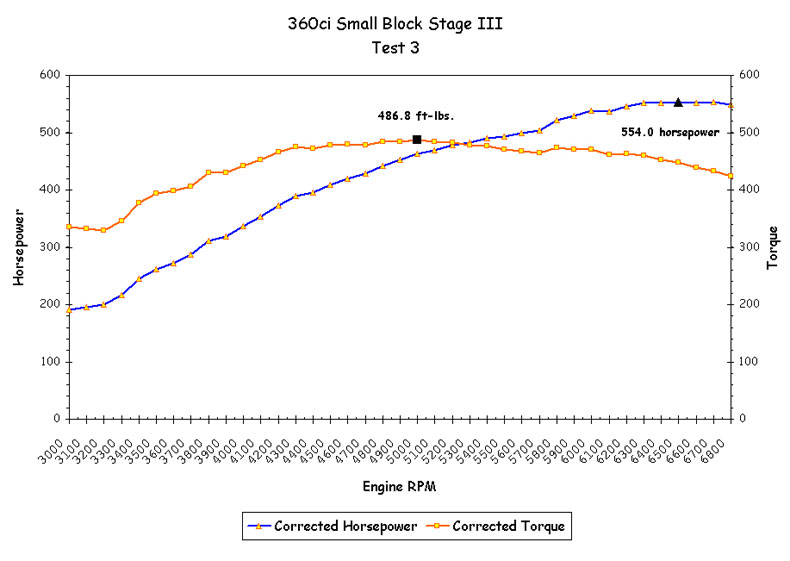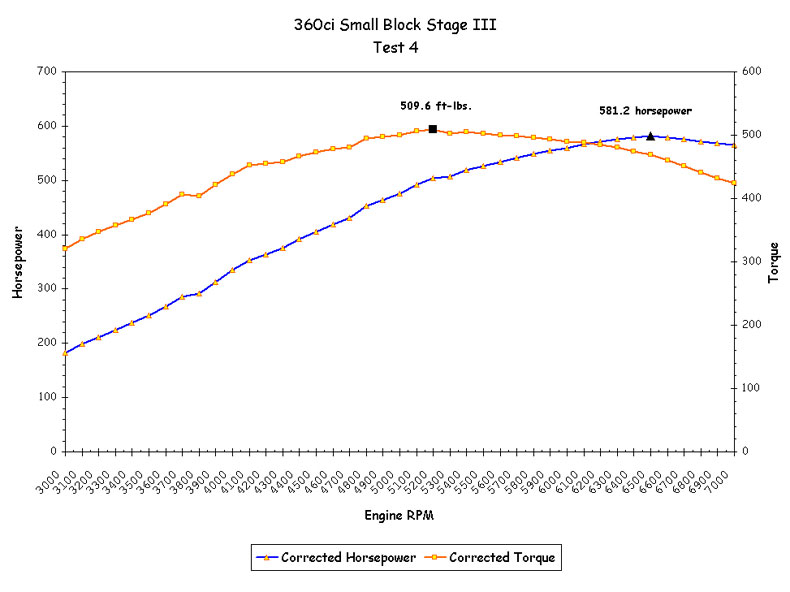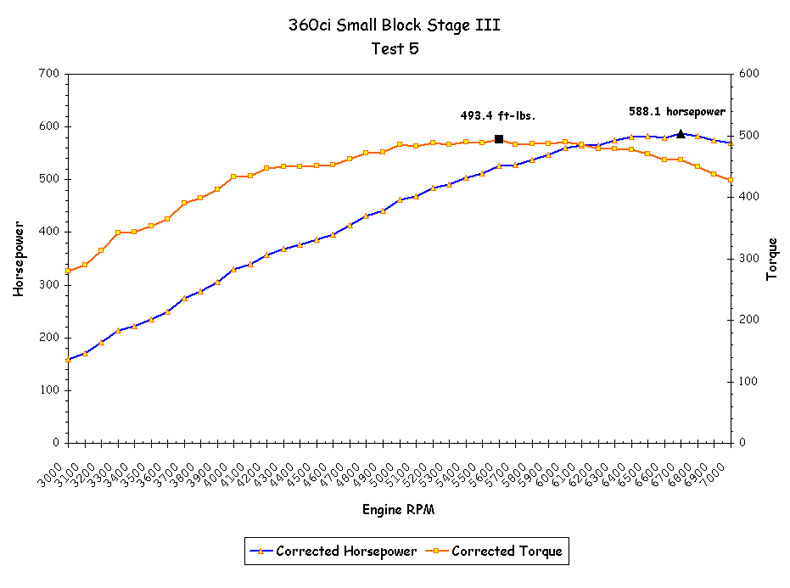|
|
#12---360 Stage 3 Dyno Test | 12/2/2021 |
|
The dyno test shown here was from an engine we built in our shop and it was dyno tested by our staff. This is our Stage III 360ci build-up and was tested in 1999. In this series of dyno pulls we tested 2 different cams, a flat tappet and a solid roller. We also tested three intakes; a Victor 340, a stock M-1 and a modified M-1. Also tested at this time were different cylinder block honing techniques. The engine used a set of '576 casting cylinder heads that were ported to our 1999, Stage II level. This engine should be a benchmark for 360's with iron "LA" type heads and flat tappet cams.
Dyno Test 1:
This test was with a stock M-1 intake manifold.
Flat Tappet solid HTL7680AS-6 cam
1.6:1 ratio rocker arms
The heads flowed 265 cfm @ .600" lift
|
Dyno Test 2:
The intake was switched to one of our modified M-1 single plane intakes. This was a very unusual power change, but very significant. At the previous power peak of 6400RPM the modified intake was worth 7.5HP more at the Test 1 peak of 6400RPM but it kept pulling and was worth 23 more horsepower up at 6700RPM. The torque change was similar in both amount and peak rpm as in Test 1. Compared to Test 1, the modified intake was worth much torque from 5000RPM up to peak of 18 ft-lbs more at 6700RPM. This modified intake pulls like a freight train and doesn't quit.
Results: 549.4HP @ 6700RPM and 499.4 ft-lbs torque @ 4900RPM
 Click here for larger image of Dyno test #2
Click here for larger image of Dyno test #2
|
Dyno Test 3:
A modified, Edelbrock Victor 340 intake with a deep port matching and a reworked plenum was installed. Compared to the modified M-1, in Test 2, it was slightly stronger from 6000RPM up to a peak of about 7HP higher at its peak which was also 100RPM higher at 6500RPM. The Victor intake's torque was down about 13 ft-lbs at its peak of 5000RPM but started to pass the M-1 at 6200RPM to a peak of 8 ft-lbs more at the Victor's HP peak of 6500RPM and fell off at about the same rate but again, at 100RPM higher.
From about 4300RPM and up, the modified M-1 has greater horsepower (about 10-13 more) until 6200RPM when the modified Victor edges ahead. The modified M-1 would be the best choice, especially in a heavy car/driver combo of about 2800lbs or more, due to its much stronger and wider torque curve. If the coefficient of drag was very low and a very high stall converter was used, the Victor might be a better choice...maybe!
Also note that the stock M-1 was stronger than the Victor until 5800RPM and at 6500RPM the Victor made 15HP more. The Victor only made more torque from 6100RPM and higher.
Results: 554.0HP @ 6500RPM and 486.8 ft-lbs torque @ 5000RPM
 Click here for larger image of Dyno test #3
Click here for larger image of Dyno test #3
|
|
Dyno Test 4:
We were not satisfied with the sealing of the rings and the resultant cranking cylinder pressures. The engine was disassembled and the cylinder hone pattern was changed. At the same time we installed stepped headers and switched back to the modified M-1 intake.
Compare this test to test #2. The difference was the honing and the stepped headers, mostly the honing, as the cylinder pressure increased..... a lot!
Results: 581.2HP @ 6500RPM and 509.6 ft-lbs torque @ 5200RPM
 Click here for larger image of Dyno test #4
Click here for larger image of Dyno test #4
|
Dyno Test 5:
The intake was switched to the modified Victor 340. And we see the same results as before (Test 2 vs. Test 3). The modified M-1 was much stronger (more than 15HP and sometimes up to 20HP) between 4300RPM and 5500RPM. From 5500RPM to 6600RPM, the M-1 is equal to or slightly ahead. At 6700RPM the Victor kicks in 10 more horsepower and at the same time the M-1 is dropping 3HP. By 6600RPM they were equal.
The torque column was again the same pattern as the horsepower. The modified M-1 was much stronger from 3000RPM to 5500RPM, as much as 27 ft-lbs more at 4600RPM. Again the Victor 340 is only greater than the modified M-1 from 6700RPM, but by then the race is over.
Results: 588.1HP @ 6700RPM and 493.4 ft-lbs torque @ 5600RPM
 Click here for larger image of Dyno test #5
Click here for larger image of Dyno test #5
|
|
Dyno Test 6:
The flat tappet camshaft that had been used in Test 1 thru 5 was changed to a solid roller tappet cam that was 7 smaller on the intake. The cam was a custom roller so it was not your run-of-the-mill, mail-order, shelf stock camshaft. As you would expect with a smaller cam and a roller camshaft, the engine was a torque monster on the lower end. The torque was up 43 ft-lbs more at 3000RPM. This 40+ ft-lbs advantage held up well to its peak of 5000RPM where it was still up 48 ft-lbs. Even though the larger flat tappet cam continued to increase its torque up to 5300RPM, the roller was still 36 ft-lbs ahead. Again in the horsepower column the roller was always ahead and even though it peaked 200RPM earlier, it was always stronger than the flat tappet cam. At 5000RPM it was 45HP more, at 5500RPM it was 29HP more, and at 13HP more at 6000RPM. You can figure a roller cam like this is will cost you about $550.00 more, is it worth it to you?
Unfortunately, our time on the dyno ran out and we were not able to try the modified M-1 intake again. However, based on previous tests it is safe to assume that the horsepower would have peaked at about the same rpm but the curve would have been much fatter and broader especially from 4000 to 6000 rpm, with maybe a 3-5 horsepower loss. The torque would also be considerably stronger possible as much as 15-20 ft-lbs more. We estimate 582HP at 6500RPM and 541 ft-lbs torque at 5100RPM.
This is with a EER6774AS-6 camshaft. This is what is known as an "Inverse Roller Cam".
1.00" 4 hole spacer.
1.00" 1 hole spacer
|
|
Conclusion and What the tests Prove:
It is clear that the engine could have used some more air. This test was run in 1999 and since then we have improved the cylinder heads, but still there are no better intakes available...yet! The engine was using oval track, stepped headers 1 5/8"- 1 " with a 3" collector. With a set of 1 "-1 7/8" or straight 1 7/8" pipes with a 3 " collector the torque would have dropped some but the magic 600HP should have shown up. The LA heads are not done yet, and you can expect to get 600+ HP with a cast iron 360 and flat tappet camshaft.
Note: Today, 2011, the Super Victor intake would be the best choice for this comparison.
|
|
|
| | Home | Phone: 309-745-9558 | Email: information@hughesengines.com |



